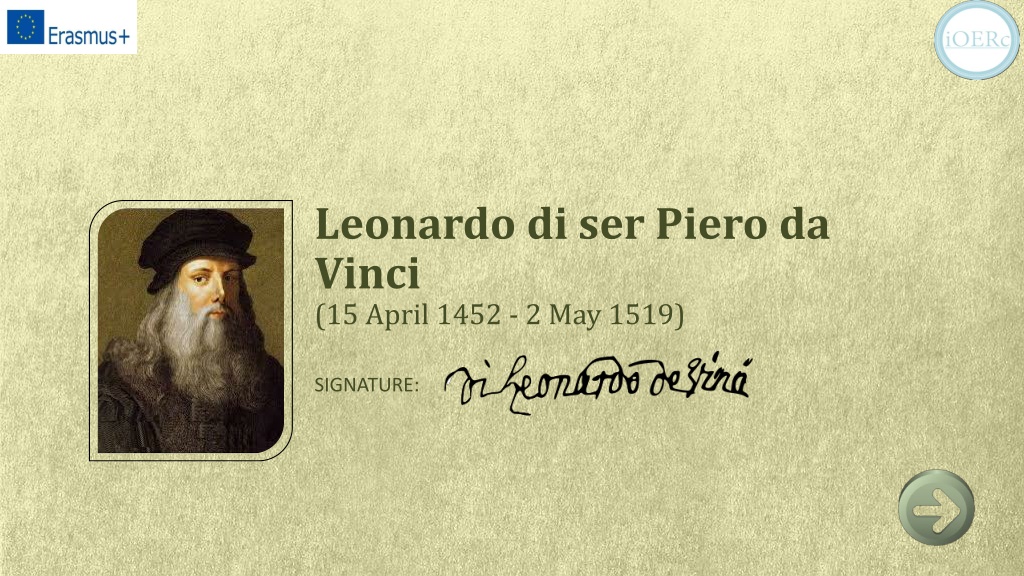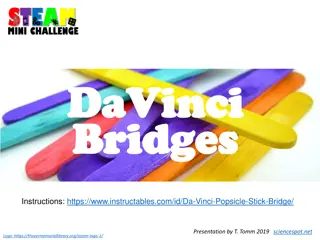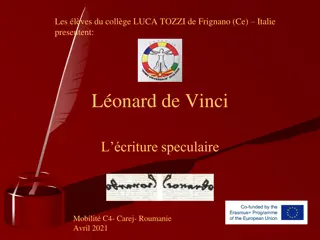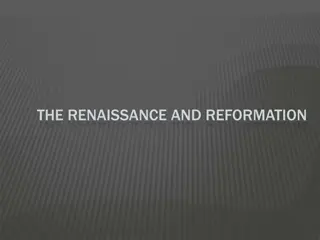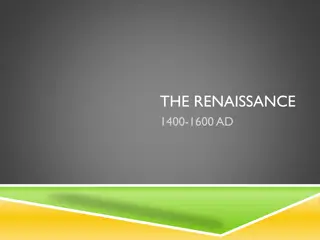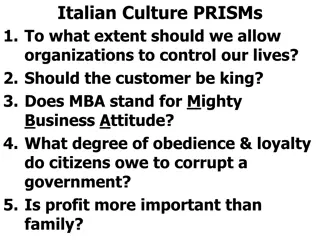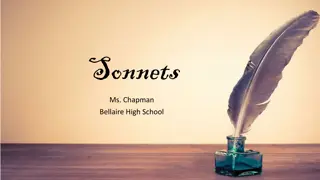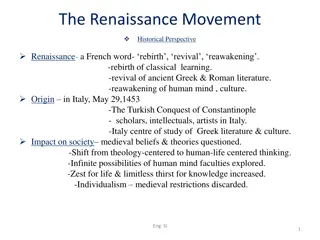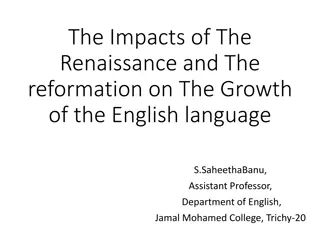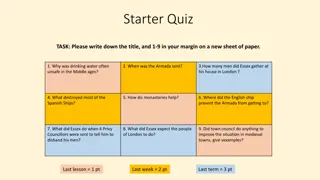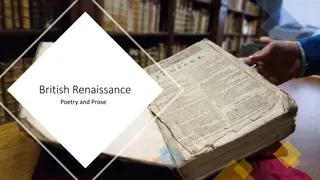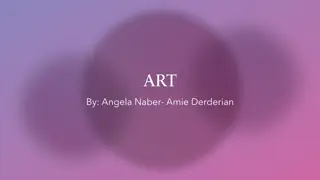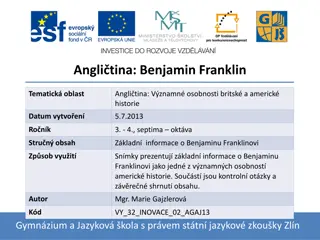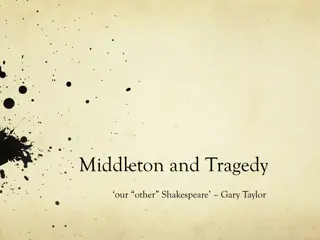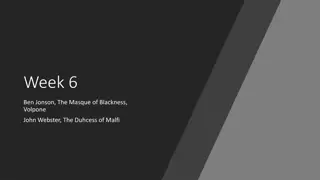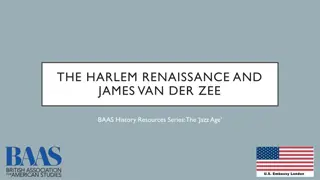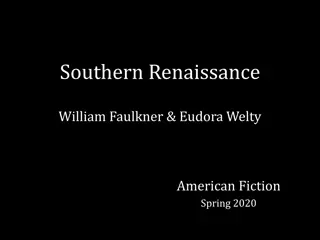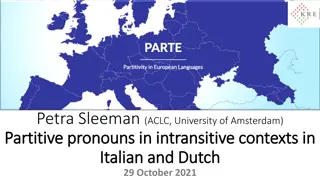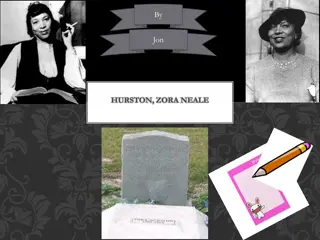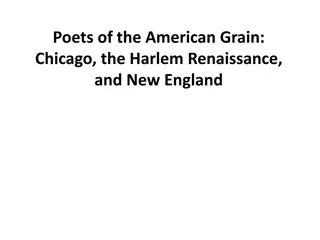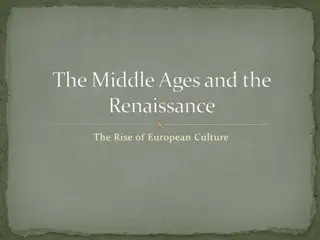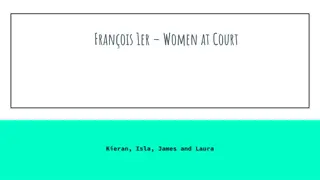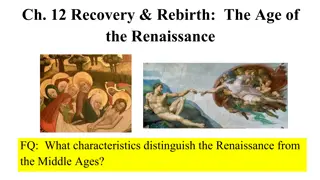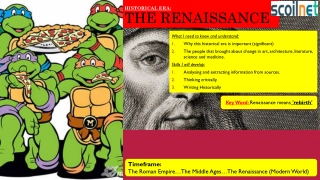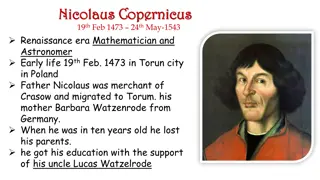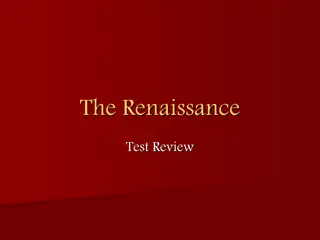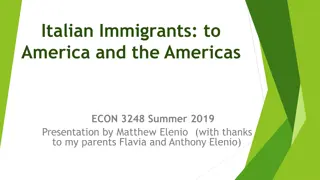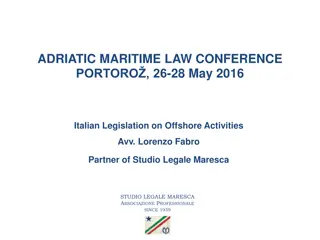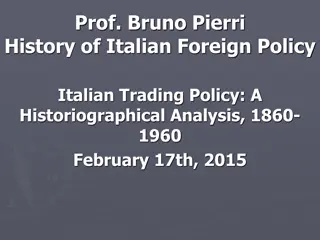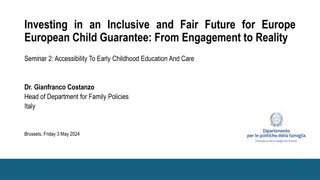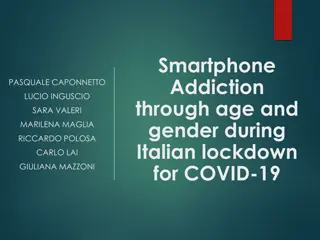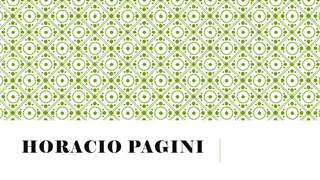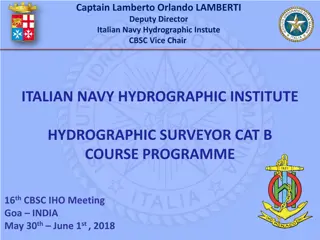Leonardo da Vinci - Italian Polymath and Renaissance Genius
Italian polymath Leonardo da Vinci, born on April 15, 1452, was a pioneer in fields such as invention, painting, sculpting, science, mathematics, engineering, and more. Revered as the "Universal Genius" of the Renaissance era, his vast interests and innovative spirit left a lasting impact on various disciplines. Known for iconic works like the Mona Lisa and The Last Supper, his contributions continue to inspire and fascinate generations.
Download Presentation

Please find below an Image/Link to download the presentation.
The content on the website is provided AS IS for your information and personal use only. It may not be sold, licensed, or shared on other websites without obtaining consent from the author. Download presentation by click this link. If you encounter any issues during the download, it is possible that the publisher has removed the file from their server.
E N D
Presentation Transcript
Leonardo di ser Piero da Vinci (15 April 1452 - 2 May 1519) SIGNATURE:
Leonardo da Vinci Italian polymath Areas of interest: invention, painting, sculpting, architecture, science, music, mathematics, engineering, literature, anatomy, geology, astronomy, botany, writing, history, and cartography. He has been variously called the father of palaeontology, ichnology, architecture; Considered one of the greatest painters of all time
Leonardo da Vinci Sometimes credited with the inventions of the parachute, helicopter and tank, he epitomised the Renaissance humanist ideal. Regarded as the prime exemplar of the "Universal Genius" or "Renaissance Man", an individual of "unquenchable curiosity" and "feverishly inventive imagination".
Leonardo da Vinci According to art historian Helen Gardner, the scope and depth of his interests were without precedent in recorded history, and "his mind and personality seem to us superhuman, while the man himself mysterious and remote". Marco Rosci notes that while there is much speculation regarding his life and personality, his view of the world was logical rather than mysterious, and that the empirical methods he employed were unorthodox for his time.[ Born out of wedlock to a notary, Piero da Vinci, and a peasant woman, Caterina, in Vinci in the region of Florence, Leonardo was educated in the studio of the renowned Florentine painter Andrea del Verrocchio. Much of his earlier working life was spent in the service of Ludovico il Moro in Milan. He later worked in Rome, Bologna and Venice, and he spent his last years in France at the home awarded to him by Francis I of France.
Leonardo da Vinci Leonardo was, and is, renowned primarily as a painter. Among his works, the Mona Lisais the most famous and most parodied portrait[6] and The Last Supperthe most reproduced religious painting of all time. Perhaps fifteen of his paintings have survived. Nevertheless, these few works, together with his notebooks, which contain drawings, scientific diagrams, and his thoughts on the nature of painting, compose a contribution to later generations of artists rivalled only by that of his contemporary, Michelangelo.
Leonardo da Vinci Leonardo is revered for his technological ingenuity. He conceptualised flying machines, a type of armoured fighting vehicle, concentrated solar power, an adding machine, and the double hull. Relatively few of his designs were constructed. Some of his smaller inventions, however, such as an automated bobbinwinder and a machine for testing the tensile strength of wire, entered the world of manufacturing unheralded. A number of Leonardo's most practical inventions are nowadays displayed as working models at the Museum of Vinci. He made substantial discoveries in anatomy, civil engineering, geology, optics, and hydrodynamics, but he did not publish his findings and they had no direct influence on later science. Today, Leonardo is widely considered one of the most diversely talented individuals ever to have lived.
Childhood, 14521466 Leonardo was born on 15 April 1452 (Old Style) "at the third hour of the night in the Tuscan hill town of Vinci, in the lower valley of the Arno river in the territory of the Medici-ruled Republic of Florence. He was the out-of- wedlock son of the wealthy Messer Piero Fruosino di Antonio da Vinci, a Florentine legal notary, and Caterina, a peasant. Leonardo had no surname in the modern sense "da Vinci" simply meaning "of Vinci"; his full birth name was "Lionardo di ser Piero da Vinci", meaning "Leonardo, (son) of (Mes)ser Piero from Vinci". The inclusion of the title "ser" indicated that Leonardo's father was a gentleman.
Childhood, 14521466 Little is known about Leonardo's early life. He spent his first five years in the hamlet of Anchiano in the home of his mother, and from 1457 lived in the household of his father, grandparents and uncle in the small town of Vinci. His father had married a sixteen-year-old girl named Albiera Amadori, who loved Leonardo but died young in 1465 without children. When Leonardo was sixteen (1468), his father married again to twenty-year-old Francesca Lanfredini, who also died without children. Piero's legitimate heirs were born from his third wife Margherita di Guglielmo (who gave birth to six children:Antonio, Giulian, Maddalena, Lorenzo, Violante and Domenico) and his fourth and final wife, Lucrezia Cortigiani (who bore him another six children: Margherita, Benedetto, Pandolfo, Guglielmo, Bartolomeo and Giovanni).
Childhood, 14521466 Leonardo received an informal education in Latin, geometry and mathematics. In later life, Leonardo recorded only two childhood incidents. One, which he regarded as an omen, was when a kite dropped from the sky and hovered over his cradle, its tail feathers brushing his face.The second occurred while he was exploring in the mountains: he discovered a cave and was both terrified that some great monster might lurk there and driven by curiosity to find out what was inside. Leonardo's early life has been the subject of historical conjecture.Vasari, the 16th-century biographer of Renaissance painters, tells a story of Leonardo as a very young man: A local peasant made himself a round shield and requested that Ser Piero have it painted for him. Leonardo responded with a painting of a monster spitting fire that was so terrifying that Ser Piero sold it to a Florentine art dealer, who sold it to the Duke of Milan. Meanwhile, having made a profit, Ser Piero bought a shield decorated with a heart pierced by an arrow, which he gave to the peasant.
Verrocchio's workshop, 146676 In 1466, at the age of fourteen, Leonardo was apprenticed to the artist Andrea di Cione, known as Verrocchio, whose bottega (workshop) was "one of the finest in Florence".He apprenticed as a garzone (studio boy) to Andrea del Verrocchio, the leading Florentine painter and sculptor of his day (and would do so for 7 years). Leonardo would have been exposed to both theoretical training and a vast range of technical skills, including drafting, chemistry, metallurgy, metal working, plaster casting, leather working, mechanics and carpentry as well as the artistic skills of drawing, painting, sculpting and modelling. Much of the painted production of Verrocchio's workshop was done by his employees. According to Vasari, Leonardo collaborated with Verrocchio on his The Baptism of Christ, painting the young angel holding Jesus' robe in a manner that was so far superior to his master's that Verrocchio put down his brush and never painted again, although this is believed to be apocryphal. Close examination reveals areas that have been painted or touched-up over the tempera using the new technique of oil paint; the landscape, the rocks seen through the brown mountain stream and much of the figure of Jesus bearing witness to the hand of Leonardo. Leonardo may have been the model for two works by Verrocchio: the bronze statue of David in the Bargello and the Archangel Raphael in Tobias and the Angel. By 1472, at the age of twenty, Leonardo qualified as a master in the Guild of Saint Luke, the guild of artists and doctors of medicine, but even after his father set him up in his own workshop, his attachment to Verrocchio was such that he continued to collaborate with him. Leonardo's earliest known dated work is a drawing in pen and ink of the Arno valley, drawn on 5 August 1473.
Professional life, 14761513 Florentine court records of 1476 show that Leonardo and three other young men were charged with sodomy but acquitted; homosexual acts were illegal in Renaissance Florence. In 1478, he left Verrocchio's studio and was no longer resident at his father's house. One writer, the "Anonimo" Gaddiano, claims that in 1480 Leonardo was living with the Medici and working in the Garden of the Piazza San Marco in Florence, a Neo- Platoni academy of artists, poets and philosophers that the Medici had established. In January 1478, he received an independent commission to paint an altarpiece for the Chapel of St. Bernard in the Palazzo Vecchio; in March 1481, he received a second independent commission for The Adoration of the Magifor the monks of San Donato a Scopeto. Neither commission was completed, the second being interrupted when Leonardo went to Milan. In 1482, Leonardo, who according to Vasari was a talented musician, created a silver lyre in the shape of a horse's head. Lorenzo de' Medici sent Leonardo to Milan, bearing the lyre as a gift, to secure peace with Ludovico Sforza, Duke of Milan. At this time Leonardo wrote an often-quoted letter describing the many marvellous and diverse things that he could achieve in the field of engineering and informing Ludovico that he could also paint. Leonardo worked in Milan from 1482 until 1499. He was commissioned to paint the Virgin of the Rocks for the Confraternity of the Immaculate Conception and The Last Supper for the monastery of Santa Maria delle Grazie. In the spring of 1485, Leonardo travelled to Hungary on behalf of Ludovico to meet Matthias Corvinus, for whom he is believed to have painted a Holy Family.Between 1493 and 1495, Leonardo listed a woman called Caterina among his dependents in his taxation documents. When she died in 1495, the list of funeral expenditures suggests that she was his mother.
Professional life, 14761513 Leonardo was employed on many different projects for Ludovico, including the preparation of floats and pageants for special occasions, designs for a dome for Milan Cathedral and a model for a huge equestrian monument to Francesco Sforza, Ludovico's predecessor. Seventy tons of bronze were set aside for casting it. The monument remained unfinished for several years, which was not unusual for Leonardo. In 1492, the clay model of the horse was completed. It surpassed in size the only two large equestrian statues of the Renaissance, Donatello's Gattamelata in Padua and Verrocchio's Bartolomeo Colleoni in Venice, and became known as the "Gran Cavallo". Leonardo began making detailed plans for its casting;however, Michelangelo insulted Leonardo by implying that he was unable to cast it. In November 1494, Ludovico gave the bronze to be used for cannon to defend the city from invasion by Charles VIII.
Professional life, 14761513 In Cesena in 1502, Leonardo entered the service of Cesare Borgia, the son of Pope Alexander VI, acting as a military architect and engineer and travelling throughout Italy with his patron. Leonardo created a map of Cesare Borgia's stronghold, a town plan of Imola in order to win his patronage. Maps were extremely rare at the time and it would have seemed like a new concept. Upon seeing it, Cesare hired Leonardo as his chief military engineer and architect. Later in the year, Leonardo produced another map for his patron, one of Chiana Valley, Tuscany, so as to give his patron a better overlay of the land and greater strategic position. He created this map in conjunction with his other project of constructing a dam from the sea to Florence, in order to allow a supply of water to sustain the canal during all seasons.
Old age, 15131519 From September 1513 to 1516, under Pope Leo X, Leonardo spent much of his time living in the Belvedere in the Vatican in Rome, where Raphael and Michelangelo were both active at the time. In October 1515, King Francis I of France recaptured Milan. On 19 December, Leonardo was present at the meeting of Francis I and Pope Leo X, which took place in Bologna. Leonardo was commissioned to make for Francis a mechanical lion that could walk forward then open its chest to reveal a cluster of lilies. In 1516, he entered Francis' service, being given the use of the manor house Clos Luc , now a public museum, near the king's residence at the royal Ch teau d'Amboise. He spent the last three years of his life here, accompanied by his friend and apprentice, Count Francesco Melzi, and supported by a pension totalling 10,000 scudi.
Old age, 15131519 Leonardo died at Clos Luc , on 2 May 1519. Francis I had become a close friend. Vasari records that the king held Leonardo's head in his arms as he died, although this story, beloved by the French and portrayed in romantic paintings by Ingres, M nageot and other French artists, as well as by Angelica Kauffman, may be legend rather than fact.Vasari states that in his last days, Leonardo sent for a priest to make his confession and to receive the Holy Sacrament. In accordance with his will, sixty beggars followed his casket.Melzi was the principal heir and executor, receiving, as well as money, Leonardo's paintings, tools, library and personal effects. Leonardo also remembered his other long-time pupil and companion, Salai, and his servant Battista di Vilussis, who each received half of Leonardo's vineyards. His brothers received land, and his serving woman received a black cloak "of good stuff" with a fur edge. Leonardo da Vinci was buried in the Chapel of Saint- Hubert in Ch teau d'Amboise in France. Some 20 years after Leonardo's death, Francis was reported by the goldsmith and sculptor Benvenuto Cellini as saying: "There had never been another man born in the world who knew as much as Leonardo, not so much about painting, sculpture and architecture, as that he was a very great philosopher."
Florence: Leonardo's artistic and social background Leonardo's youth was spent in a Florence that was ornamented by the works of these artists and by Donatello's contemporaries, Masaccio, whose figurative frescoes were imbued with realism and emotion, and Ghiberti, whose Gates of Paradise, gleaming with gold leaf, displayed the art of combining complex figure compositions with detailed architectural backgrounds. Piero della Francesca had made a detailed study of perspective, and was the first painter to make a scientific study of light. These studies and Alberti's treatise De Pictura were to have a profound effect on younger artists and in particular on Leonardo's own observations and artworks.
Florence: Leonardo's artistic and social background A prevalent tradition in Florence was the small altarpiece of the Virgin and Child. Many of these were created in tempera or glazed terracotta by the workshops of Filippo Lippi, Verrocchio and the prolific della Robbia family. Leonardo's early Madonnas such asThe Madonna with a carnationand the Benois Madonnafollowed this tradition while showing idiosyncratic departures, particularly in the case of the Benois Madonna in which the Virgin is set at an oblique angle to the picture space with the Christ Child at the opposite angle. This compositional theme was to emerge in Leonardo's later paintings such as The Virgin and Child with St. Anne.
Florence: Leonardo's artistic and social background In 1476, during the time of Leonardo's association with Verrocchio's workshop, the Portinari Altarpiece by Hugo van der Goes arrived in Florence, bringing from Northern Europe new painterly techniques that were to profoundly affect Leonardo, Ghirlandaio, Perugino and others. In 1479, the Sicilian painter Antonello da Messina, who worked exclusively in oils, travelled north on his way to Venice, where the leading painter Giovanni Bellini adopted the technique of oil painting, quickly making it the preferred method in Venice. Leonardo was also later to visit Venice.
Florence: Leonardo's artistic and social background With Alberti, Leonardo visited the home of the Medici and through them came to know the older Humanist philosophers of whom Marsiglio Ficino, proponent of Neo Platonism; Cristoforo Landino, writer of commentaries on Classical writings, and John Argyropoulos, teacher of Greek and translator of Aristotle were the foremost. Also associated with the Academy of the Medici was Leonardo's contemporary, the brilliant young poet and philosopher Pico della Mirandola.Leonardo later wrote in the margin of a journal, "The Medici made me and the Medici destroyed me." While it was through the action of Lorenzo that Leonardo received his employment at the court of Milan, it is not known exactly what Leonardo meant by this cryptic comment.
Personal life Within Leonardo's lifetime, his extraordinary powers of invention, his "outstanding physical beauty", "infinite grace", "great strength and generosity", "regal spirit and tremendous breadth of mind", as described by Vasari, as well as all other aspects of his life, attracted the curiosity of others. One such aspect was his respect for life, evidenced by his vegetarianism and his habit, according to Vasari, of purchasing caged birds and releasing them. Leonardo appears to have had no close relationships with women except for his friendship with Cecilia Gallerani and the two Este sisters, Beatrice and Isabella. While on a journey that took him through Mantua, he drew a portrait of Isabella that appears to have been used to create a painted portrait, now lost.
Assistants and pupils Gian Giacomo Caprotti da Oreno, nicknamed Salai, entered Leonardo's household in 1490. After only a year, Leonardo made a list of his misdemeanours, calling him "a thief, a liar, stubborn, and a glutton", after he had made off with money and valuables on at least five occasions and spent a fortune on clothes. Nevertheless, Leonardo treated him with great indulgence, and he remained in Leonardo's household for the next thirty years. Salai executed a number of paintings under the name of Andrea Salai, but although Vasari claims that Leonardo "taught him a great deal about painting", his work is generally considered to be of less artistic merit than others among Leonardo's pupils, such as Marco d'Oggiono and Boltraffio. In 1515, he painted a nude version of the Mona Lisa, known as Monna Vanna. Salai owned the Mona Lisa at the time of his death in 1525, and in his will it was assessed at 505 lire, an exceptionally high valuation for a small panel portrait. In 1506, Leonardo took on another pupil, Count Francesco Melzi, the son of a Lombard aristocrat, who is considered to have been his favourite student. He travelled to France with Leonardo and remained with him until Leonardo's death. Melzi inherited the artistic and scientific works, manuscripts, and collections of Leonardo and administered the estate.
Painting Among the qualities that make Leonardo's work unique are his innovative techniques for laying on the paint; his detailed knowledge of anatomy, light, botany and geology; his interest in physiognomy and the way humans register emotion in expression and gesture; his innovative use of the human form in figurative composition; and his use of subtle gradation of tone. All these qualities come together in his most famous painted works, the Mona Lisa, the Last Supper, and the Virgin of the Rocks.[74]
Early works Leonardo first gained notoriety for his work on the Baptism of Christ, painted in conjunction with Verrocchio. Two other paintings appear to date from his time at Verrocchio's workshop, both of which are Annunciations. One is small, 59 centimetres (23 in) long and 14 centimetres (5.5 in) high. It is a "predella" to go at the base of a larger composition, a painting by Lorenzo di Credi from which it has become separated. The other is a much larger work, 217 centimetres (85 in) long. In both Annunciations, Leonardo used a formal arrangement, like two well-known pictures by Fra Angelico of the same subject, of the Virgin Mary sitting or kneeling to the right of the picture, approached from the left by an angel in profile, with a rich flowing garment, raised wings and bearing a lily. Although previously attributed to Ghirlandaio, the larger work is now generally attributed to Leonardo.
Paintings of the 1480s mportant work is the Virgin of the Rocks, commissioned in Milan for the Confraternity of the Immaculate Conception. The painting, to be done with the assistance of the de Predis brothers, was to fill a large complex altarpiece. Leonardo chose to paint an apocryphal moment of the infancy of Christ when the infant John the Baptist, in protection of an angel, met the Holy Family on the road to Egypt. The painting demonstrates an eerie beauty as the graceful figures kneel in adoration around the infant Christ in a wild landscape of tumbling rock and whirling water. While the painting is quite large, about 200 120 centimetres, it is not nearly as complex as the painting ordered by the monks of St Donato, having only four figures rather than about fifty and a rocky landscape rather than architectural details. The painting was eventually finished; in fact, two versions of the painting were finished: one remained at the chapel of the Confraternity, while Leonardo took the other to France. The Brothers did not get their painting, however, nor the de Predis their payment, until the next century.
Paintings of the 1490s Leonardo's most famous painting of the 1490s is The Last Supper, commissioned for the refectory of the Convent of Santa Maria della Grazie in Milan. It represents the last meal shared by Jesus with his disciples before his capture and death, and shows the moment when Jesus has just said "one of you will betray me", and the consternation that this statement caused.
Paintings of the 16th century Among the works created by Leonardo in the 16th century is the small portrait known as the Mona Lisa or "la Gioconda", the laughing one. In the present era it is arguably the most famous painting in the world. Its fame rests, in particular, on the elusive smile on the woman's face, its mysterious quality perhaps due to the subtly shadowed corners of the mouth and eyes such that the exact nature of the smile cannot be determined. The shadowy quality for which the work is renowned came to be called "sfumato", or Leonardo's smoke. Vasari, who is generally thought to have known the painting only by repute, said that "the smile was so pleasing that it seemed divine rather than human; and those who saw it were amazed to find that it was as alive as the original".[
Murals Leonardo's The Battle of Anghiara was a fresco commissioned in 1505 for the Salone dei Cinquecento (Hall of the Five Hundred) in the Palazzo Vecchio, Florence. Its central scene depicted four men riding raging war horses engaged in a battle for possession of a standard, at the Battle of Anghiari in 1440. At the same time his rival Michelangelo, who had just finished his David, was designated the opposite wall. All that remains of Leonardo's work is a copy by Rubens, but Maurizio Seracini is convinced it can still be found and has spent a lifetime searching for it. He was allowed to drill some pilot holes in a mural in the Salone dei Cinquecento, Palazzo Vecchio, Florence, and his team did find evidence of an oil painting underneath.
Leonardo di ser Piero da Vinci (15 April 1452 - 2 May 1519)
